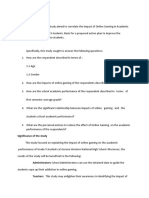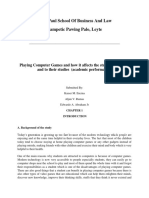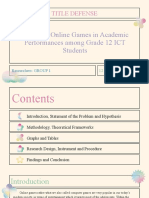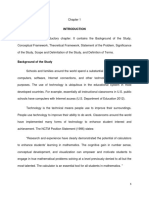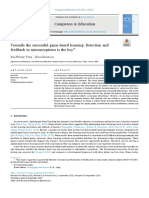The Effects of Educational Computer Games On Students' Attitudes Towards Mathematics Course and Educational Computer Games
The Effects of Educational Computer Games On Students' Attitudes Towards Mathematics Course and Educational Computer Games
Uploaded by
nidaCopyright:
Available Formats
The Effects of Educational Computer Games On Students' Attitudes Towards Mathematics Course and Educational Computer Games
The Effects of Educational Computer Games On Students' Attitudes Towards Mathematics Course and Educational Computer Games
Uploaded by
nidaOriginal Title
Copyright
Available Formats
Share this document
Did you find this document useful?
Is this content inappropriate?
Copyright:
Available Formats
The Effects of Educational Computer Games On Students' Attitudes Towards Mathematics Course and Educational Computer Games
The Effects of Educational Computer Games On Students' Attitudes Towards Mathematics Course and Educational Computer Games
Uploaded by
nidaCopyright:
Available Formats
Available online at www.sciencedirect.
com
Procedia Social and Behavioral Sciences 1 (2009) 145149
World Conference on Educational Sciences 2009
The effects of educational computer games on students attitudes towards
mathematics course and educational computer games
Serkan ankayaa*, Ayen Karameteb
a
b
Computer Education and Instructional Technology, Anadolu University, Eskiehir, Turkey
Computer Education and Instructional Technology, Balkesir University, Balkesir, Turkey
Received September 27,2008; revised December 11 , 2008; accepted January 2, 2009
Abstract
The purpose of this research is to determine the differences of attitudes of students, who played the educational computer games developed for this
research, towards both mathematics course and educational computer games. For this reason, researchers developed two educational computer
games, Proportional Tetris and Proportional Clown, which are about ratio and proportion topic in mathematics education. Researchers used a survey
including a demographic data form and two likert-like scales about both mathematics course and educational computer games. Educational
computer games and the survey were applied to 176 students in two primary schools in Balikesir, Turkey. Whether educational computer games
affected the students attitudes towards both mathematics course and educational computer games was tested with Paired Samples t test. Whether
there is a meaningful relationship between students attitudes towards mathematics course and students attitudes towards educational computer
games was tested with Pearson Correlation test. As a result, students attitudes towards both mathematics course and educational computer games
became positive. But there wasnt any change in attitudes of students who played Proportional Tetris and Proportional Clown.
2009 Elsevier Ltd. Open access under CC BY-NC-ND license.
Keywords: Educational computer games; digital game based learning; ratio and proportion; mathematics teaching.
1. Introduction
Recent rapid development of computers and technology forces educational institutions to use it in solving educational and
instructional problems. Although education and technology are different terms, using them together introduce a new concept,
educational technology. Educational technology makes teaching and learning activities enjoyable. Thanks to educational technology,
students learn with playing, having fun and loving (Isman, 2005).
Computer aided instruction is the method that students can see their performance, control their learning with getting feedbacks,
engage the lesson with graphics, sounds, animations and figures (Baki, 2002).
Effectiveness of computer aided instruction is substantially related with the quality of the courseware. While good quality
software affects the students success positively, bad quality software can cause waste of time and getting undesired behaviors for
students (Demirel et al., 2003).
One of the applications of computer aided education is educational computer games. There are many researches about effects of
games on childrens cognitive development and conceptual approaches to games. The most important studies in this subject were
performed by Piaget and Vygotsky. These studies became the reference point for the later studies in this subject.
* Serkan ankaya. Tel.: +90-505-284-4685.
E-mail address: serkancankaya@anadolu.edu.tr
1877-0428 2009 Elsevier Ltd. Open access under CC BY-NC-ND license.
doi:10.1016/j.sbspro.2009.01.027
146
Serkan ankaya et al. / Procedia Social and Behavioral Sciences 1 (2009) 145149
Vygotsky thought that game contributes to the cognitive development importantly instead of reflecting the cognitive development
simply (Nicolopoulou, 2004).
Educational computer games, which include motivational and funny features of computer games, can be used as an alternative or
supportive to the other instructional methods in the direction of instructional or educational goals.
According to Prensky (2001a) there are six structural factors which make a game a game:
1. Rules: Rules impose limits and they force us to take specific paths to reach goals and ensure that all the players take the same
paths.
2. Goals or Objectives: Goals or objectives create duty sense on us. So we play the game voluntarily and spend time and make
an effort for it.
3. Outcomes and Feedback: Outcomes and feedback are how you measure your progress against the goals. Feedback comes
when something in the game changes in response to what you do.
4. Conflict, Competition, Challenge and Opposition: Conflict, competition, challenge and opposition are the problems in a game
you are trying to solve.
5. Interaction: Interaction has two important aspects. The first is the interaction of the player and the computer. The second is
inherently social aspect of games that you do with other people.
6. Representation: Representation means that the game is about something.
According to Prensky (2002), students motives for learning are a mixture of intrinsic goals and extrinsic rewards, combined with
psychological factors such as fear and need to please. If strong enough, these motives can and do pull students through to the end.
According to Rieber (1996; cited by Can, 2003), educational computer games are the best way for students to be responsible for their
learning.
Students grow up in a quite different environment than their parents in todays world. They have used technological tools in all of
their life. And this situation has affected their points of view, lifestyles, and expectations enormously. According to the research
performed by Tapscott (1997), students are very different from their parents in the point of learning, playing, communicating,
working and creating societies.
1.1. Importance
In mathematics education, generally the methods of narration and question-answer are used. But these methods bring along that
students expect ready information and they dont enforce themselves to retrieve information and dont query the correctness of the
information. Besides these method can be boring for students. For an effective instruction, students are required to be motivated and
actively participate in the lesson.
In mathematics education, there is a need for the information learned and used when required instead of the information learned
and forgotten. Computer is an appropriate tool for students to reach the information directly by learning by doing. Educational
computer games, a branch of computer aided instruction, are important alternatives to prepare the environment mentioned here.
Thanks to the educational computer games, students can learn by doing, experiencing, and enjoying without getting bored. Students
can learn easily by concreting abstract concepts in the electronic environment.
Even though all these positive approaches convince the mathematics teachers to use education computer games in their lessons,
there is not enough number of research performed in this topic and developed educational computer games in Turkey. This situation
necessitates new researches to be done in this topic.
1.2. Purpose
The purpose of this research is to determine the differences of attitudes of students, who played the educational computer games
which were developed for this research, towards both mathematics course and educational computer games.
1.3. Research Questions
The main problem of this research is that whether educational computer games developed for this research have an influence on
the attitudes of students towards both mathematics course and educational computer games.
The sub questions of the main problem are in the following:
1. Is there any significant difference in attitudes of students towards mathematics course between before and after they played the
educational computer games?
2. Is there any significant difference in attitudes of students towards educational computer games between before and after they
played the educational computer games?
3. Is there any significant relationship between the attitudes of students towards mathematics course and the attitudes of students
towards educational computer games?
147
Serkan ankaya et al. / Procedia Social and Behavioral Sciences 1 (2009) 145149
2. Method
Data was collected from 176 7th grade students in two primary schools in Balikesir, Turkey. Cluster sampling method was used to
select students. The frequency distribution of the students is given in Table 1.
Table 1. Students Schools and Genders
Male
f
44
41
Schools
Atatrk Primary School
Fatih Primary School
%
25,0
23,3
Female
f
50
41
Total
F
94
82
%
28,4
23,3
%
53,4
46,6
Students demographic data form and two likert-like scales about the attitudes of students towards both mathematics course and
educational computer games were combined in a form and applied to the students.
In the students demographic data part of the survey, there are personal questions like their school, age, parents educational
background and job, whether there is a computer at home, where to use computer, how often they use computer, what computer
means for them, whether they want to start a job related with computer in the future, lessons they like, whether parents let them to
play computer games, how often they play computer games, how many years they have played computer games.
The likert-like scale about the attitudes of students towards mathematics course was obtained from the Internet address of Ministry
of National Educations site (http://ogm.meb.gov.tr/mat_9.doc). Reliability of the scale was tested with Cronbach Alpha coefficient
and calculated as 0.795. According to this value, the scale was appeared to be quite reliable.
In the likert-like scale about the attitudes of students towards educational computer games, there are 24 items. 13 of them were
obtained from the survey developed by Can (2003). Other 11 items were developed by the researchers. Pilot study was performed
with 7th grade students in Zagnospasa Primary school in Balikesir. According to the results of pilot study and the experts views, the
scale was given final shape. Reliability of the scale was tested with Cronbach Alpha coefficient and calculated as 0.661. According to
this value, the scale was appeared to be reliable enough.
Firstly students were applied the survey. And then they played the educational computer games, Proportional Tetris and
Proportional Clown. Whey they played the games sufficient time enough, they were applied only the scales part of the survey again.
3. Findings
The findings of this research were obtained from the survey applied to the students. Statistical results are given in the following
3.1. Students Attitudes towards both Mathematics Course and Educational Computer Games
According to the results of the scale, it was appeared that the most of the students had positive attitudes towards mathematics
lesson. 79% of them selected Strongly Agree or Agree choices in the item I can learn mathematics. 73% of them selected Strongly
Disagree or Disagree choices in the item Mathematics is annoying for me with negative meaning.
Most of the students had also positive attitudes towards educational computer games. 83.5% of them gave the positive answer to
the item I like playing computer games. 72.1% of them gave the positive answer to the item I think that computer games can be
used for educational purposes.
3.2. The Effect of Playing Educational Computer Games on the Students Attitudes towards Mathematics Course
Whether there is any significant difference between the students total attitudes scores towards mathematics course calculated
before and after they played the educational computer games was tested with Paired Samples T test. Results of this test were given in
Table 2.
Table 2. Paired Samples T Test for the Students Attitudes towards Mathematics Course Before and After
Differences between
Before
After
N
79
79
X
47,85
49,13
SS
9,089
7,682
X
-1,278
SS
Df
8,252
-1,377
78
,172
148
Serkan ankaya et al. / Procedia Social and Behavioral Sciences 1 (2009) 145149
As seen in Table 2, it was appeared that there was not any significant difference between the students total attitudes scores
towards mathematics course calculated before and after they played the educational computer games (t(78) = -1,377, p>0,05).
3.3. The Effect of Playing Educational Computer Games on the Students Attitudes towards Educational Computer Games
Whether there is any significant difference between the students total attitudes scores towards educational computer games
calculated before and after they played the educational computer games was tested with Paired Samples T test. Results of this test
were given in Table 3.
Table 3. Paired Samples T Test for the Students Attitudes towards Educational Computer Games Before and After
Differences between
Before
After
N
53
53
X
84,72
86,17
SS
10,758
10,655
X
-1,453
SS
df
10,074
-1,050
52
0,299
As seen in Table 3, it was appeared that there was not any significant difference between the students total attitudes scores
towards educational computer games calculated before and after they played the educational computer games (t(52) = -1,050, p>0,05).
3.4. The Relationship between the Students Attitudes towards Mathematics Course and the Students Attitudes towards Educational
Computer Games
The relationship between two variables, students attitudes towards mathematics course and the students attitudes towards
educational computer games, was tested with Pearson correlation. Pearson correlation coefficient was calculated as 0.177. As a
result, it was appeared that there was a low level positive significant relationship between these two variables. In other words, it can
be said that students who have positive attitudes towards mathematics course have also positive attitudes towards educational
computer games.
4. Conclusion
Most of the students have positive attitudes towards mathematics course. In addition it was appeared that most of them have also
positive attitudes towards educational computer games. Findings in literature are parallel with this finding (Prensky, 2001a).
Attitudes of students towards mathematics course did not changed after they played the educational computer games. Attitudes
generally change difficultly and it takes long time. Students have already positive attitudes towards mathematics course. So it can be
said that this finding is normal and expectable.
Attitudes of students towards educational computer games did not changed after they played the educational computer games.
Having already positive attitudes and time limitation to play educational computer games could cause this result to happen. If more
and various educational computer games were used and application time extended, students would have more positive attitudes
towards educational computer games. According to the experimental researches in literature, it was concluded that educational
computer games can be used for educational purposes effectively (Mitchell & Savill-Smith, 2004; Can, 2003; Tzn et al.., 2006).
It is come to light that students who have positive attitudes towards mathematics course have also positive attitudes towards
educational computer games. According to this finding, it can be said that students who are successful in mathematics course have
also positive attitudes towards educational computer games.
As a result it can be said that educational computer games can be used as a supportive to the other instructional methods in the
direction of instructional or educational goals.
There is not enough number of research performed and educational computer games developed in Turkey. So, more researches
should be performed in this subject area.
References
Baki, A. (2002). renen ve retenler iin Bilgisayar Destekli Matematik. stanbul: Tbitak Bitav-Ceren Yaynlar.
Can, G. (2003). Perceptions Of Prospective Computer Teachers Toward The Use Of Computer Games With Educational Features In Education, Unpublished Master
of Science Thesis, The Middle East University.
Demirel, ., Seferolu, S.S., & Yac, E. (2003). retim Teknolojileri ve Materyal Gelitirme. Ankara: Pegem A Yaynlar.
Mitchell, A., Savill-Smith, C. (2004). The Use of Computer and Video Games for Learning - A Review of Literature. URL
http://www.lsda.org.uk/files/PDF/1529.pdf.
Nicolopoulou, A. (2004). Oyun, Bilisel Geliim ve Toplumsal Dnya: Piaget, Vygotsky ve Sonras. Ankara niversitesi Eitim Bilimleri Fakltesi Dergisi, 37(2),
137-169.
Prensky, M. (2001a). Digital Game-Based Learning. New York: McGraw-Hill.
Serkan ankaya et al. / Procedia Social and Behavioral Sciences 1 (2009) 145149
149
Prensky, M. (2001b). Digital Natives Digital Immigrants. NCB University Press.
Prensky, M. (2002). The Motivation of Gameplay or, the REAL 21th Century Learning Revolution. URL http://www.marcprensky.com/writing/Prensky%20%20The%20Motivation%20of%20Gameplay-OTH%2010-1.pdf.
Tapscott, D. (1997). Growing up Digital : The Rise of the Net Generation. New York: McGraw-Hill.
Tzn, H., Ylmaz, M., Karaku, T., nan, Y., & Kzlkaya, G. (2006). Bilgisayar Oyunlarnn rencilerin renme ve Motivasyonuna Olan Etkileri. Akademik
Biliim 06.
You might also like
- Statement of The ProblemDocument17 pagesStatement of The ProblemFrance de Peralta91% (55)
- The Effect of Computer Games On Speed, Attention and Consistency of Learning Mathematics Among StudentsDocument6 pagesThe Effect of Computer Games On Speed, Attention and Consistency of Learning Mathematics Among StudentsDiah Dwi SantriNo ratings yet
- ResearchDocument13 pagesResearchkobejohngicosNo ratings yet
- Rob Final Asg Etec 500Document14 pagesRob Final Asg Etec 500api-378883636No ratings yet
- The Impact of Game-Based Learning On The Achievement of Learning Goals and Motivation For Learning Mathematics - Literature ReviewDocument16 pagesThe Impact of Game-Based Learning On The Achievement of Learning Goals and Motivation For Learning Mathematics - Literature ReviewHydon Biñas LibradillaNo ratings yet
- SWTIRIA MOYDocument8 pagesSWTIRIA MOYVladimir MarkovskyNo ratings yet
- A Study On The Effectiveness of Computer Games in Teaching and LearningDocument7 pagesA Study On The Effectiveness of Computer Games in Teaching and LearningIJASCSENo ratings yet
- Development and Impact of Strategic Intervention Material in Mathematics 7Document10 pagesDevelopment and Impact of Strategic Intervention Material in Mathematics 7Cyrene Joy BermidoNo ratings yet
- 3is Research ProposalDocument17 pages3is Research ProposalHarold MaribojocNo ratings yet
- MEDT 8484 - BenjaminGreen - Media and Technology Future ResearchDocument4 pagesMEDT 8484 - BenjaminGreen - Media and Technology Future Researchbenjamin greenNo ratings yet
- Saint Paul School of Business and Law Campetic Pawing Palo, LeyteDocument18 pagesSaint Paul School of Business and Law Campetic Pawing Palo, LeytePaul MillsNo ratings yet
- Effects of Educational Games Towards Senior High School Students LearningDocument9 pagesEffects of Educational Games Towards Senior High School Students LearningBarcenas Roger Jr.No ratings yet
- Chapter I The Problem and Its BackgroundDocument57 pagesChapter I The Problem and Its BackgroundkrizahblancaNo ratings yet
- 2014 - Children's Engagement During Digital Game-Based Learning of Reading by RonimusDocument10 pages2014 - Children's Engagement During Digital Game-Based Learning of Reading by RonimusNguyen UyenNo ratings yet
- Chapter I Impact of Game Based Supplementary Materials On Numeracy Skills Development Among Primary LearnersDocument12 pagesChapter I Impact of Game Based Supplementary Materials On Numeracy Skills Development Among Primary LearnersRicky Sto Tomas100% (1)
- 64 Integration2010 ProceedingsDocument9 pages64 Integration2010 ProceedingsKhirulnizam Abd RahmanNo ratings yet
- Results and FinDocument4 pagesResults and FinmarjjohnpalaniaNo ratings yet
- Research Defense - Effects of Online GamesDocument24 pagesResearch Defense - Effects of Online GamesAllen Domasing100% (1)
- Computers & Education: Mansureh Kebritchi, Atsusi Hirumi, Haiyan BaiDocument17 pagesComputers & Education: Mansureh Kebritchi, Atsusi Hirumi, Haiyan BaiAngela WeaslyNo ratings yet
- Research For Grade 12 Copy OnlyDocument14 pagesResearch For Grade 12 Copy OnlyLovely Marjorie GutierrezNo ratings yet
- The Impact of Video Games in Children's Learning of MathematicsDocument7 pagesThe Impact of Video Games in Children's Learning of MathematicsJohn Paul Canlas SolonNo ratings yet
- Students' Perceptions Towards Educational Games Learning Media in MathematicsDocument5 pagesStudents' Perceptions Towards Educational Games Learning Media in MathematicsMaira SalsabilaNo ratings yet
- I, IIDocument3 pagesI, IIfaithjoshua.elardoNo ratings yet
- Saint Paul School of Business and Law Campetic Pawing Palo, LeyteDocument19 pagesSaint Paul School of Business and Law Campetic Pawing Palo, LeyteAnonymous cBknxKNo ratings yet
- 02 PDFDocument16 pages02 PDFAndrés SarmientoNo ratings yet
- TryGo: A Mobile Game Application in PreCalculusDocument103 pagesTryGo: A Mobile Game Application in PreCalculusJMV Dela CruzNo ratings yet
- GameEnhancedLearning Meletiou EnglishDocument28 pagesGameEnhancedLearning Meletiou EnglishMaria MeletiouNo ratings yet
- Comparing the Social Skills of Students Addicted to Computer Games with Normal Students - PMCDocument11 pagesComparing the Social Skills of Students Addicted to Computer Games with Normal Students - PMCGrace mockNo ratings yet
- Examining the Efficacy of GameDocument10 pagesExamining the Efficacy of Gameuyalexa164No ratings yet
- Chapter 222Document37 pagesChapter 222Eros NarvazaNo ratings yet
- Attitudes of Egyptian Teachers Towards ComputersDocument11 pagesAttitudes of Egyptian Teachers Towards ComputersJemaz79No ratings yet
- Investigating The Impact of Kahoot! On Students' Engagement, Motivation, and Learning Outcomes Ifrane Directorate As A Case StudyDocument9 pagesInvestigating The Impact of Kahoot! On Students' Engagement, Motivation, and Learning Outcomes Ifrane Directorate As A Case StudyInternational Journal of Advance Study and Research WorkNo ratings yet
- Adriane-RESEARCH-PAPEr 3Document11 pagesAdriane-RESEARCH-PAPEr 3adrianeenerva0No ratings yet
- Effectiveness of Educational Games in Improving STDocument17 pagesEffectiveness of Educational Games in Improving STharem bakirNo ratings yet
- Related Studies and Related LiteratureDocument5 pagesRelated Studies and Related LiteratureHazel Anne R. RebutiacoNo ratings yet
- GameDocument8 pagesGamegabriela harghelNo ratings yet
- Parent's Perspective On Educational GamesDocument14 pagesParent's Perspective On Educational GamesSurya Amami PramudityaNo ratings yet
- Educational Games For Teaching Computer Programming: June 2014Document13 pagesEducational Games For Teaching Computer Programming: June 2014Quratulain KanwalNo ratings yet
- s10936 023 09983 yDocument21 pagess10936 023 09983 yLuís TeixeiraNo ratings yet
- Computers & Education: Kai-Hsiang Yang, Bou-Chuan LuDocument13 pagesComputers & Education: Kai-Hsiang Yang, Bou-Chuan LuFollet TortugaNo ratings yet
- Examining primary school educators preferences for using digital versus non-digital games to support mathematics instructionDocument27 pagesExamining primary school educators preferences for using digital versus non-digital games to support mathematics instructionmuhdbazliNo ratings yet
- Chad Tobin Paper April 6Document22 pagesChad Tobin Paper April 6api-256859696No ratings yet
- The Influence of Online GamesDocument86 pagesThe Influence of Online GamescadauanestevenNo ratings yet
- The Effects of Mobile Games and The Student'S Academic Performances Among Grade 9 Students of New Ilang Achievers Academy IncorporatedDocument3 pagesThe Effects of Mobile Games and The Student'S Academic Performances Among Grade 9 Students of New Ilang Achievers Academy IncorporatedRaul PastiasNo ratings yet
- Chang Et Al. - 2016 - The Effects of An Educational Video Game On Mathematical EngagementDocument15 pagesChang Et Al. - 2016 - The Effects of An Educational Video Game On Mathematical EngagementOrbis TertiusNo ratings yet
- Effects of Online Games To The Academic Performance of Grade 11 Students of Mandurriao National High SchoolDocument27 pagesEffects of Online Games To The Academic Performance of Grade 11 Students of Mandurriao National High SchoolcetinoNo ratings yet
- Computer Literacy Learning Emotions of ODL Teacher-Students PDFDocument10 pagesComputer Literacy Learning Emotions of ODL Teacher-Students PDFEliezerFerreiraSilvaNo ratings yet
- The Problem and The Related LiteratureDocument25 pagesThe Problem and The Related LiteratureKister Quin EscanillaNo ratings yet
- The Advantage and Disadvantage of Computer On Academic Performace For Grade 11 Students of Arthur Clark in Informatics College NorthgateDocument11 pagesThe Advantage and Disadvantage of Computer On Academic Performace For Grade 11 Students of Arthur Clark in Informatics College NorthgateCaine Michael GarciaNo ratings yet
- Ejel Volume15 Issue4 Article607Document12 pagesEjel Volume15 Issue4 Article607Yo AsakuraNo ratings yet
- Computer Game Development For Balancing Chemical EDocument14 pagesComputer Game Development For Balancing Chemical EJudileen GandinoNo ratings yet
- Research PaperDocument12 pagesResearch Paperclarkroda3No ratings yet
- E LearningDocument25 pagesE LearningAlyanna Mae M. Salinas100% (1)
- Research Carmonacantera FinalDocument84 pagesResearch Carmonacantera FinalMONIC STRAISAND DIPARINENo ratings yet
- Baimau PPNCDocument15 pagesBaimau PPNCPhương LãNo ratings yet
- CHAPTER 1 Ian AJ Nihao Wao 3Document10 pagesCHAPTER 1 Ian AJ Nihao Wao 3Ajay JumagdaoNo ratings yet
- The Role of Computer Games in Enhancing Primary School Students Attitude Towards MathematicsDocument7 pagesThe Role of Computer Games in Enhancing Primary School Students Attitude Towards MathematicsIJAR JOURNALNo ratings yet
- Middle East Technical University Department of Elementary and Early Childhood Education 2024 Spring SemesterDocument10 pagesMiddle East Technical University Department of Elementary and Early Childhood Education 2024 Spring Semesterapi-734845630No ratings yet
- Research Paper G11 ICT 2DA Carl AngeloDocument32 pagesResearch Paper G11 ICT 2DA Carl Angelodevera kristianNo ratings yet
- The New Education - Fighting Technology (and Boredom) for the Attention of StudentsFrom EverandThe New Education - Fighting Technology (and Boredom) for the Attention of StudentsNo ratings yet
